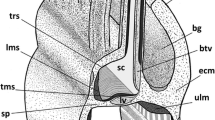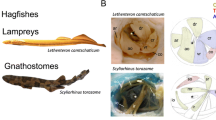Summary
Comparative ultrastructural analyses of the muscles that work the lantern of Aristotle support the opinion that the muscles in question are myoepithelially organized or derivatives of myoepithelia. They are part of the epithelium of the peripharyngeal cavity (=lantern coelom). The coelom epithelium may become multiplelayered in certain regions and is composed of (1) a layer of muscle cells that vary in number and size, (2) nerve cells and their processes that are interspersed between the muscle layer and (3) monociliated adluminal cells that build a continuous cell lining and completely cover the muscle layer. According to their complexity, the lantern muscles exhibit consecutive stages of myoepithelial variations and may finally simulate subepithelial musculature. The results of this study support the hypothesis of a histological development of subepithelial musculature from simple myoepithelia, although both epithelial and mesenchymal musculature may occur in the Echinodermata. Detailed knowledge of the organization of the lantern's coelom space was a prerequisite for the present study. In contrast to previous examinations the lantern coelom is not a continuous space, but is subdivided into several cavities that are partially completely separated from each other. On the one hand, this subdivision is probably caused by the sophisticated arrangement of the lantern's ossicles and on the other by the septa that give rise to muscles that fulfill different functions. lanter's ossicles and on the other by the septa that give
Similar content being viewed by others
References
Andrietti F, Candia Carnevali MD, Wilkie IC, Lanzavecchia G, Melone G, Celentano FC (1990) Mechanical analysis of the sea-urchin lantern: the overal system in Paracentrotus lividus. J Zool (Lond) 220: 345–366
Buchanan JB (1969) Feeding and the control of volume within the tests of regular sea-urchins. J Zool (Lond) 159: 51–64
Burke RD (1980) Development of pedicellariae in the pluteus larva of Lytechinus pictus (Echinodermata, Echinoidea). Can J Zool 58: 1674–1682
Candia Carnevali MD, Bonasoro F, Andrietti F, Melone G, Wilkie IC (1990) Functional morphology of the peristomial membrane of regular sea-urchins: structural organization and mechanical properties in Paracentrotus lividus. De Ridder, Dubois, Lahaye and Jangoux (eds) Echinoderm research. Balkema, Rotterdam, pp 207–216
Cavey MJ, Wood RL (1990) Organization of the adluminal and retractor cells in the coelomic lining from the tube foot of a phanerozonian starfish, Luidia foliolata. Can J Zool 69: 911–923
Cobb JLS (1968) The fine structure of the pedicellariae of Echinus esculentus (L.). I. The innervation of the muscles. J R Microsc Soc 88: 211–221
Cobb JLS, Laverack MS (1966) The lantern of Echinus esculentus (L.). I. Gross anatomy and physiology. Proc Roy Soc Lond B 164: 624–640
Cuénot L (1948) Anatomie, ethologie et systematique des échinodermes. In: Grassé PP (ed): Traité de Zoologie, vol XI, Masson, Paris, pp 242–272
Grimmer JC, Holland ND (1979) Haemal and coelomic circulatory systems in the arms and the pinnules of Florimetra serratissima (Echinodermata: Crinoidea). Zoomorphology 94: 93–109
Hilgers H, Splechtna H (1981) Zur Feinstruktur ophiocephaler Pedizellarien von Arbacia lixula (Linné) (Echinodermata, Echinoidea). Zoomorphology 97: 89–100
Hyman LH (1955) The invertebrates. IV. Echinodermata. McGraw-Hill, New York
Lanzavecchia G, Candia Carnevali MD, Melone G, Celentano FC, Andrietti F (1988) Aristole's lantern in the regular sea urchin Paracentrotus lividus. I. Functional morphology and significance of bones, muscles and ligaments. Burke et al. (eds) Echinoderm biology, Balkema, Rotterdam
Märkel K (1979) Structure and growth of the cidaroid socket-joint lantern of Aristotle compared to the hinge-joint lanterns of non-cidaroid regular echinoids (Echinodermata, Echinoidea). Zoomorphology 94: 1–32
Märkel K, Gorny P (1973) Zur funktionellen Anatomie der Seeigelzähne. Z Morph Tiere 75: 233–242
Märkel K, Röser U (1983) The spine tissues in the echinoid Eucidaris tribuloides. Zoomorphology 103: 25–41
Märkel K, Röser U (1991) Ultrastructure and organization of the epineural canal and the nerve cord in sea urchins. Zoomorphology 110: 267–279
Märkel K, Röser U (1992) Functional anatomy of the valves in the ambulacral system of sea urchins (Echinodermata, Echinoida). Zoomorphology 111: 179–192
Märkel K, Gorny P, Abraham K (1977) Microarchitecture of sea urchin teeth. Fortschr Zool 24: 103–114
Märkel K, Röser U, Stauber M (1990) The interpyramidal muscle of Aristotle's lantern: its myoepithelial structure and its growth (Echinodermata, Echinoida). Zoomorphology 109: 251–262
Märkel K, Mackenstedt U, Röser U (1992) The sphaeridia of sea urchins: ultrastructure and supposed function. Zoomorphology 112: 1–10
Peters BH, Campbell AC (1987) Morphology of the nervous and muscular systems in the heads of pedicellariae from the sea urchin Echinus esculentus L. J Morphol 193: 35–51
Rieger RM (1986) Über den Ursprung der Bilateria: die Bedeutung der Ultrastrukturforschung für ein neues Verstehen der Metazoenevolution. Verh Dtsch Zool Ges 79: 31–50
Rieger RM, Lombardi J (1987) Ultrastructure of coelomic lining in echinoderm podia: significance for concepts in the evolution of muscle and peritoneal cells. Zoomorphology 107: 191–208
Saita A (1969) La morfologia ultrastrutturale dei muscoli della “Lanterna di Aristotele” di alcuni Echinoidei. Ist Lomb Rend Sci B 103: 297–313
Smith DS, Wainwright SA, Baker J, Cayer ML (1981) Structural features associated with movement and “catch” of sea-urchin spines. Tissue Cell 13: 299–320
Stauber M, Märkel K (1988) Comparative morphology of muscleskeleton attachments in the Echinodermata. Zoomorphology 108: 137–148
Wilkie IC, Candia Carnevali MD, Bonasoro F (1992) The compass depressors of Paracentrotus lividus (Echinodermata, Echinoida): ultrastructural and mechanical aspects of their tensility and contractility. Zoomorphology 112: 143–153
Author information
Authors and Affiliations
Rights and permissions
About this article
Cite this article
Stauber, M. The lantern of Aristotle: organization of its coelom and origin of its muscles (Echinodermata, Echinoida). Zoomorphology 113, 137–151 (1993). https://doi.org/10.1007/BF00403091
Received:
Issue Date:
DOI: https://doi.org/10.1007/BF00403091




